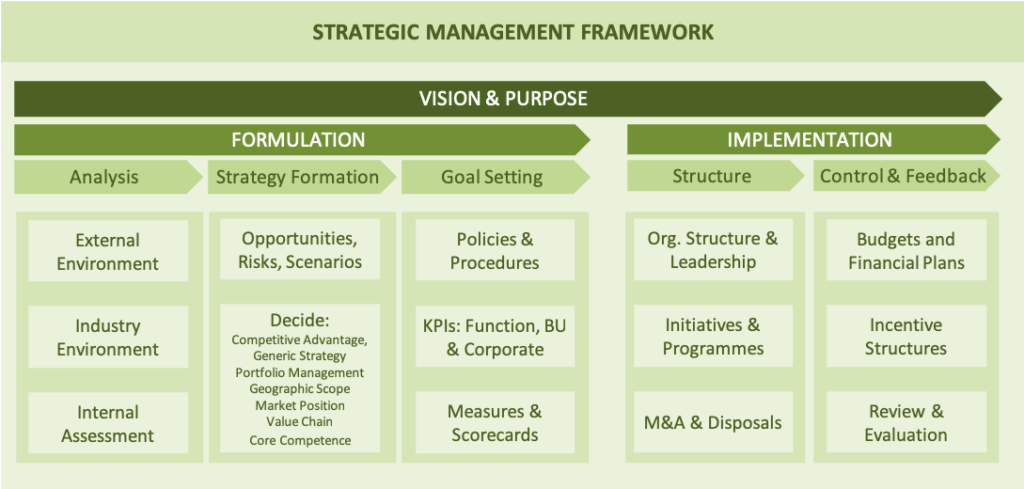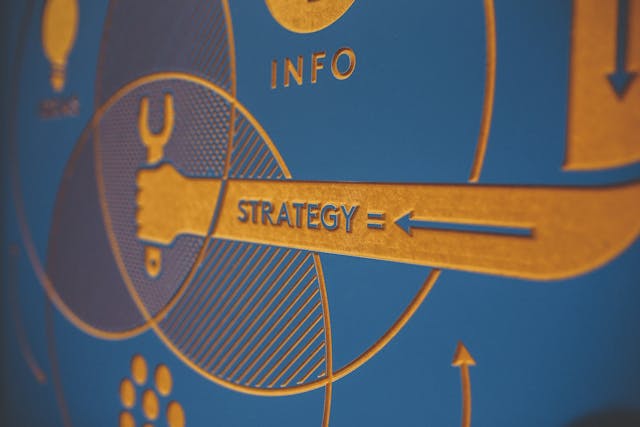The Strategic Management framework is a high level summary of a cyclical process of strategy creation. It splits strategy into a repeated formulation and implementation phases, each of which has its own sub-steps and activities.
Summary by The World of Work Project
Strategic Management Framework
The strategic management framework provides a detailed overview of the strategy process adopted by many organizations.
This framework separates the strategy process into three high level activities: defining vision and mission, formulating strategy and implementing strategy.

Stage 1: Vision and Purpose (or Mission)
As with the VMOSA framework, the first activity that needs to be completed when following the Strategic Management Framework is the creation of an organizational vision and mission.
The organization’s vision and mission then go on to be a constant point of reference throughout the remainder of the organization’s strategy process.
Stage 2: Strategy Formulation
The second stage of this framework takes an organization through the process of formulating a strategy. This is done in several sub-stages.
Analysis
The first part of strategy formulation is analysis of the current state. It’s impossible to decide on and create a strategy if you don’t understand the lay of the land, so analyzing a wide range of factors is the first stage of the strategic process.
At this stage organizations consider and analyze a range of factors including: the wider economy, their industry and their own specific capabilities, strengths and weaknesses. There are a wide range of strategic analysis tools that can help with this stage of thinking.
Strategy Formation
Once an organization understands the current state and has a detailed analysis of their environment, their industry and themselves, they can start to look forward and consider the opportunities and threats that they may face.
With this combined understanding of the current state and some future analysis, it becomes time to start thinking about what specifically the organization will do. At this stage, the organization starts to focus on how it will compete in its chosen market place or environment.
In essence, these activities are the creation of the organization’s strategy.
Goal Setting
The last part of the strategy formulation stage of the Strategic Management Framework is to create goals and targets relating to the organizations defined strategy. It’s great to know what you’re going to do at a high level, but for your strategy to be useful it needs to include specific detail to manage towards. To help with this, many organizations use Balanced Scorecards.
Concepts like SMART goals and objectives may be helpful at this stage.
Stage 3: Implementing your strategy
The third stage of this framework focuses on the implementation of strategy, which is considered to have two sub-stages.
Implementing a strategic structure
In this stage, the organization ensures it is effectively structured to deliver on its strategy. The thinking here is that before you go and do something, you need to have all your pieces in the right place.
At a practical level, this means that to be prepared to start delivering your strategy effectively, you need to have the right leaders and individuals in your organization, you need to have the right business units, you need to have the right legal structures, you need to have the right processes and policies and capital assets and you need the right strategic projects lined up to help you deliver effectively. Once these pieces are in place, you can press the big
Controlling your strategic delivery
The last part of this model considers the need to effectively control and deliver your objectives. Once you have all the right pieces in place and you press the “start” button on your strategy, you need to monitor and control your performance on a constant basis. Frequent fine-tuning is required to ensure success and feedback plays an important role in this.
The key message here is that control frameworks are essential for strategic success in most instances.
Learning More
The way we think as humans is fascinating. Cognitive biases clearly explain some of our “irrationality”. The Dunning-Kruger Effect is just one example of this. Understanding our Dual Process way of thinking provides some further insight into it. This “irrationality” means that we’re all suggestible and susceptible to nudging and the powers of choice architecture and persuasion.
Communication is another tool often used to change people’s behaviors. Ideas like the rhetorical triangle and the five canons of rhetoric shed some light on how this works. For a more detailed look at communicating for persuasion, explore Monroe’s Motivated Sequence.
Increasingly, products are also design to be persuasive, as it were. They are designed to create habits and drive increased use. Examples of this include Fogg’s model and the Hook model of behavioral design.
You might enjoy our podcast on vision and mission statements:
The World of Work Project View
The strategic management framework is helpful. Leaders us it to think comprehensively about their strategies.
In many organizations the approach to strategy is cyclical, iterating through formulation and implementation phases of roughly this process. Those cycles can be of different lengths, but a three year strategy cycle isn’t uncommon. Of course, organizations also need to look further into the future. They also need to manage their ongoing business and operations while still thinking strategically about the future.
This framework only provides a high level summary of the activities required. Anyone creating a strategy aligned to this framework should use further models to support their thinking.
As with all strategic planning, you need the right people involved in the process for it to be effective. You also need to ensure you iterate through the processes you use as things in the real world are constantly changing and evolving and in most cases while it’s possible to define a strategy at a high level, doing so doesn’t mean that you won’t need to change direction in response to changes in the real world.
The last thing we’d like to plug in here is that it would be great if your strategy helped you become a responsible business.
How We Help Organizations
We provide leadership development programmes and consulting services to clients around the world to help them become high performing organizations that are great places to work. We receive great feedback, build meaningful and lasting relationships and provide reduced cost services where price is a barrier.
Learning more about who we are and what we do it easy: To hear from us, please join our mailing list. To ask about how we can help you or your organization, please contact us. To explore topics we care about, listen to our podcast. To attend a free seminar, please check out our eventbrite page.
We’re also considering creating a community for people interested in improving the world of work. If you’d like to be part of it, please contact us.
Sources and Feedback
This post is not based on any specific books. It is based on a mix of work related experience and sources from around the internet.
We’re a small organization who know we make mistakes and want to improve them. Please contact us with any feedback you have on this post. We’ll usually reply within 72 hours.






